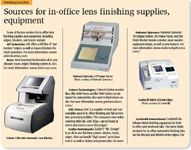When to consider adding a finishing lab
Convenience and service are two of the primary reasons optometric practices explore adding an in-office finishing lab, but they are by no means the only reasons.

Key Points
For Joslin Family Eyecare, having a lens-processing laboratory on-site is about convenience.
"If we have a patient who needs their glasses right away, we can do that for them," explains Marcie Manning, lab manager at the two-location practice on the Florida panhandle run by Franklin A. Joslin, OD, and Matthew Owens, OD. "It's great to be able to offer that service."
Convenience and service are two of the primary reasons optometric practices explore adding an in-office finishing lab, but they are by no means the only reasons. Controlling lab costs and quality control are others, as is maintaining a competitive edge in a marketplace where 1-hour chain stores are always an option for patients seeking eyeglasses.
So what factors should your practice consider before adding an in-office lab?
Cost
An in-office finishing lab is more than just an edger. A blocker and tracer are also required, although some systems have all three built into the same unit. Expect to pay at least $30,000 for the necessary equipment, and as much as $50,000 for the top-of-the line models. But be forewarned: Going cheap isn't always best. Cheaper systems are often older, meaning they are more complicated to run, requiring more operator training, and have lower throughput (read: slower and less efficient) than newer, more expensive systems.

Consider all of these costs, and compare them to current wholesale lab costs before deciding whether or not to finish on-site. Wholesale labs will sell blanks to their customers who finish on-site at a cost of roughly $3 to $7 per pair. For comparison purposes, labs charge roughly $10 to $20 per pair to finish single-vision lenses.
And remember: Not all lens orders can be finished in-office. Progressive lenses will still need to be processed at a wholesale lab unless an in-office surfacing lab is installed (Joslin surfaces on-site) and, as Manning notes, "a lot of insurance plans require you to send orders on the plan to one of their labs." Vision Service Plan (VSP), the largest eye-care insurance provider in the U.S., recently changed its policy to allow member providers to finish VSP orders on-site.
Space
This is less of an issue now than it was, say, 20 years ago, when edgers were still bulky machines. Today's finishing equipment is sleeker and has a smaller footprint than those older-line models, but practices still need to make space before they can make lenses. A minimum of 10 square feet of table space is required to allow room for the equipment and the operator, and consider the overall esthetics of the optical before you install. Not all optical shops will want their finishing labs visible to patients.